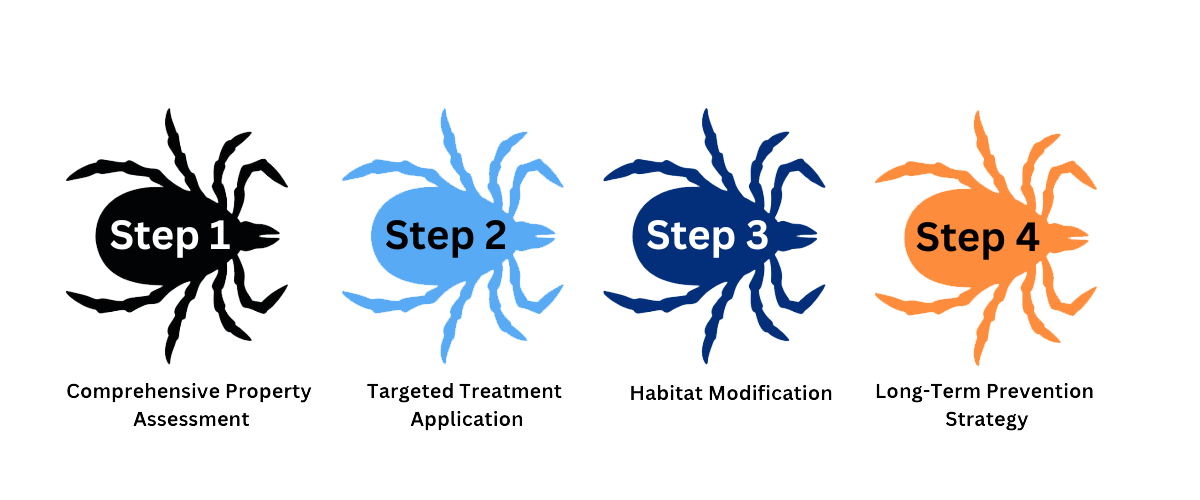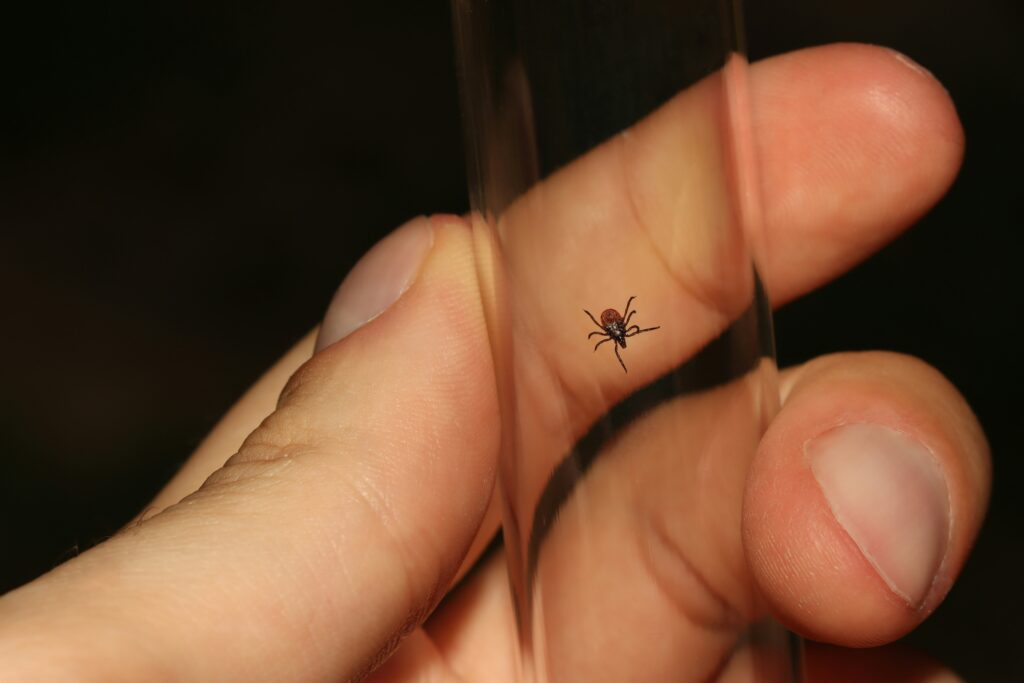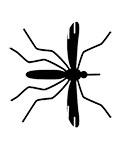Arrange for tick control and reduction services from a team in Dartmouth, MA
Do Your Part to Prevent Tick-Borne Diseases From Spreading
Ticks are known to carry diseases that can be transmitted to a host when the host is bitten. Though the diseases vary in intensity, you can take steps to avoid the issue altogether by allowing a pest control service to protect your property. Padanaram Pest Pros offers tick reduction services to clients in Dartmouth, MA, and surrounding areas.
Not only will you protect yourself by reducing the number of ticks on your property, but you'll also protect your pets. Call 774-283-3338 or contact us now to arrange for a tick yard treatment.
Did you know?
Ticks don't jump or fly. Instead, they use a behavior called "questing" where they climb up vegetation and wait for a host to pass by, then latch on.
Why trust us with tick reduction?
In order to avoid the dangers of ticks, you'll need an expert team on the job to handle your tick yard treatment. You'll want to work with us because we...
- Bring over 25 years of experience to each job
- Perform effective topical treatments with blocking agents
- Are fully licensed to get the job done right the first time
You can relax and enjoy your outdoor time without worrying about a tick infestation. Schedule tick reduction services today.

Massachusetts is home to several types of ticks, including:
1.Black-legged Tick (Deer Tick) (Ixodes scapularis):
- Found throughout Massachusetts and active year-round if temperatures are above freezing.
- Known for spreading Lyme disease, babesiosis, anaplasmosis, Borrelia miyamotoi, and Powassan virus.
- Deer tick nymphs are the size of a poppy seed, while adults are the size of a sesame seed136.
2.American Dog Tick (Dermacentor variabilis):
- Commonly found in wooded and grassy areas.
- Spreads Rocky Mountain spotted fever and tularemia.
- Adults are about the size of a watermelon seed and are most active during spring and summer136.
3.Lone Star Tick (Amblyomma americanum):
- Recently identified in certain areas like Cape Cod and the Islands.
- Can spread tularemia, ehrlichiosis, and Southern Tick-Associated Rash Illness (STARI).
- Its saliva may cause an allergy to red meat (alpha-gal syndrome)136.
4.Woodchuck Tick (Groundhog Tick) (Ixodes cookei):
- Found primarily on woodchucks but can occasionally bite humans.
- Known for spreading Powassan virus6.
Ticks in Massachusetts live in brushy, wooded, or grassy areas and can transmit diseases when they bite humans or animals
Common Tick-Borne Diseases and Their Risks
Lyme Disease:
- Caused by Borrelia burgdorferi bacteria, transmitted by black-legged (deer) ticks.
- Early symptoms include fever, fatigue, headache, and the hallmark "bull's-eye" rash.
- If untreated, it can progress to joint inflammation (arthritis), neurological issues (e.g., meningitis or Bell’s palsy), and heart problems (carditis)16.
Anaplasmosis:
- A bacterial infection spread by deer ticks.
- Symptoms include fever, chills, severe headache, muscle aches, and gastrointestinal issues.
- Severe cases can lead to respiratory distress, kidney failure, or shock, particularly in immunocompromised individuals13.
Babesiosis:
- Caused by microscopic parasites infecting red blood cells.
- Symptoms range from flu-like issues (fever, chills, fatigue) to severe complications like anemia, organ damage, or death in vulnerable populations18.
Rocky Mountain Spotted Fever (RMSF):
- Spread by the American dog tick and other species.
- Symptoms include fever, headache, muscle pain, and a characteristic rash that can progress to life-threatening complications like organ failure if untreated38.
Powassan Virus:
- A rare but severe viral infection transmitted by deer ticks.
- Symptoms include fever, headache, vomiting, and neurological complications like encephalitis or meningitis. It can cause long-term disability or death in severe cases.
Ehrlichiosis:
- Spread by the Lone Star tick.
- Symptoms include fever, chills, headache, muscle pain, and confusion. Severe cases may involve organ damage or death if untreated3.
Tularemia:
- Can cause ulcers at the bite site along with fever and swollen lymph nodes.
- Inhalation of the bacteria can lead to pneumonia-like symptoms.
Alpha-Gal Syndrome (AGS):
- Triggered by Lone Star tick bites.
- Causes an allergy to red meat due to a reaction to alpha-gal sugars introduced during the bite.
Factors That Increase Severity
- Immune System Health: Young children, elderly individuals, and those with weakened immune systems are at higher risk for severe disease outcomes1.
- Duration of Tick Attachment: Ticks must remain attached for a certain period (e.g., 24–36 hours for Lyme disease) to transmit pathogens effectively1.
- Delayed Diagnosis: Untreated infections can progress to advanced stages with more serious complications like chronic arthritis or neurological damage6.
Potential Complications
- Chronic joint pain or swelling (Lyme arthritis).
- Neurological impairments such as paralysis or cognitive dysfunction (e.g., from Lyme disease or Powassan virus).
- Organ failure or life-threatening conditions like sepsis in severe cases of babesiosis or RMSF.
Prevention Tips
- Avoid tick-prone areas (e.g., tall grass and wooded areas).
- Use tick repellents containing DEET or permethrin on skin and clothing.
- Perform thorough tick checks after outdoor activities.
- Promptly remove attached ticks using fine-tipped tweezers.
Tick-borne diseases are preventable with vigilance and early intervention. If symptoms appear after a tick bite or outdoor exposure in tick habitats, seek medical attention promptly.
Our 4-Step Tick Reduction Process
Step 1: Comprehensive Property Assessment
Our technicians thoroughly inspect your property, identifying tick breeding grounds, harborage areas, and risk zones. We'll provide a free estimate, with treatments available the same day (weather permitting).
Step 2: Targeted Treatment Application
Using environmentally responsible methods, we apply specialized treatments to eliminate existing tick populations on your property. Our approach focuses on adult ticks and larvae to break the reproductive cycle.
Step 3: Habitat Modification
We identify and address the environmental factors attracting ticks to your property. Our experts provide customized recommendations for landscape changes that create tick-resistant zones around your home.
Step 4: Long-Term Prevention Strategy
Once your property is effectively protected, we offer additional services and products to maintain a tick-free environment year-round, including preventative treatments and seasonal maintenance plans.


